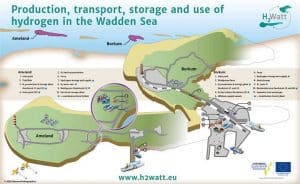Hydrogen is considered crucial to transforming the energy market, especially in the northern parts of Germany and the Netherlands with their growing number of clean energy systems. On two North Sea islands, INTERREG project H2Watt is now investigating the opportunities that a hydrogen infrastructure can provide before it will put ideas into practice. Where will it be eco-friendly to switch to hydrogen? What is the best way to accomplish this? Representing a microcosm of a supply chain, both islands offer the perfect chance to study the real-world use of hydrogen. In late April, H2Watt was kicked off by a week-long virtual event showing video clips created by the project’s partners.
In the middle of the Wadden Sea, off the coast of Germany and the Netherlands, lies an archipelago collectively known as the Frisian Islands. Two of these islands, German Borkum in the east and Dutch Ameland in the west, have been pioneering the fight against climate change in the region. Five years ago, Borkum’s council presented a list of objectives and targets the island needs to achieve by 2030, including climate neutrality. Equally ambitious plans have been announced on Ameland. Besides pursuing the same 2035 target of net-zero emissions, its council wants Ameland to become a leading supplier of clean technology and stop importing energy from the mainland. Both island governments are partners in the 10-member H2Watt project consortium.
H2Watt
The consortium have EUR 2.3 million and 26 months available to analyze the benefits and drawbacks of hydrogen use on the islands. Plans are to study, plan and set up multiple projects to simulate a hydrogen economy (see fig. 1). What kinds of projects will be carried out on which island depends on local conditions. One focus area is the transportation sector.
On both Borkum and Ameland, the consortium members plan to install an electrolyzer and a storage and delivery system. Borkum will also adapt its light rail to run on the gas. Several times a day, this train carries tourists from Borkum’s ferry dock to the only town on the island. The schedule changes with the season and while the service is used more frequently in summer, heating the train in winter requires considerably more energy. Other factors that will be evaluated prior to vehicle conversion include typical velocity profiles and running resistance.
In Ameland’s case, the focus will be on maritime transportation. The prototype to be designed and built on the island is a catamaran-type vessel that will be powered by hydrogen or a hydrogen derivative, namely methanol. Eco-friendliness, economics, legal regulations and expenses for converting existing vessel stock will play a crucial role in determining the suitability of both energy carriers.
Borkum will also build an entire quarter for the employees of nearby offshore wind farms. The buildings will be heated using thermal energy from the North Sea and the upstream stage of hydrogen production. Ameland, by contrast, will put up a biogas plant for high-pressure anaerobic digestion and use hydrogen to improve operating efficiency.
Energy profile
The 2017 and 2018 figures on energy generation and imports indicate that there has been some progress on the clean energy front. But they also show that there is still a lot to do in the short term (see fig. 3). This is particularly true for the Netherlands, where people have increasingly relied on natural gas to meet their energy needs. They will now have to rethink their strategy after the government announced that it plans to severely curtail natural gas production starting in 2022 and end it altogether by 2026. On both islands, hydrogen is used to further energy systems integration. Ameland’s council has decided to install a 3-megawatt solar farm in addition to the island’s existing 6-megawatt farm as well as several smaller PV systems totaling 1 megawatt. To prevent another volatile energy source from testing the limits of energy management and grid capacity, the new farm will be linked directly to an electrolyzer. A battery pack will serve as temporary storage, eliminating the need for spontaneous start-ups and shutdowns.
…
read more in H2-international October 2020
Author: Adenike Bettinger


























0 Comments